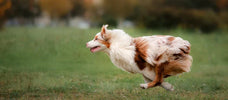
BUILDING FITNESS IN DOGS: HOW CAN YOUR DOG BECOME FITTER, STRONGER AND MORE ADAPTABLE?
, by Marc Kelchtermans, 6 min reading time

, by Marc Kelchtermans, 6 min reading time
Dog fitness isn't just about muscle mass: a fit, well-conditioned dog functions in a balanced way throughout its body and can better adapt to physical stress, whether it's sports, long walks, or simply an active, movement-rich lifestyle. But how do you build fitness, and how can we consciously help our dog achieve this?
It is important to distinguish between cardiovascular endurance and muscular fitness because these two affect different physiological systems and can be developed in different ways:
Cardiovascular endurance: This includes the efficiency of the heart, lungs, and blood vessels, which transport oxygen to the muscles and remove carbon dioxide. A dog with good cardiovascular fitness can exercise longer, tire less quickly, and recover more quickly.
Muscle condition: This includes muscle strength, endurance, flexibility, and speed. Muscle condition determines how hard a dog can move, how well it controls its movements, and how quickly it can adapt to repeated exertion.
The combined development of both components is necessary to develop and maintain full condition, especially in sporting or working dogs, but is also essential for maintaining the health of pets.
A dog in good condition:
Building fitness doesn't happen overnight. The body needs time to adapt to new demands. Based on average fitness, the first measurable changes are visible after about 4-6 weeks of regular, gradual training, while a lasting, stable fitness level is built up with months of consistent training.
A key concept in fitness development is supercompensation . This means that after a workout, the body not only returns to its original state but also rises to a slightly higher level, as if preparing for the next load.
In practice this looks like this:
Development is optimal when the new training hits the dog precisely at this supercompensated stage. If we retrain too early, the body hasn't yet recovered, meaning overload occurs. If it's too late, the body returns to its starting level, and the desired development isn't achieved.
Exercise therapy, whether physiotherapy or hydrotherapy, is an excellent complement to fitness training. Physiotherapy uses targeted exercises, stretching, and massage to help muscle recovery, reduce stiffness, improve joint mobility, and restore ideal movement patterns.
Hydrotherapy, or therapy on an underwater treadmill, is also a good option. The water relieves pressure on the joints and helps muscles work more efficiently. This allows your dog to develop endurance and muscle strength in a safe environment.
Nutritional supplements also play an important role in building fitness. Vitaltier Sport & Activity and Muscle & Tendon products support the health of athletic, active dogs with targeted active ingredients.
These products complement training and exercise therapy and help keep your dog in the best possible condition.
Building fitness in dogs is a long, conscious process. Never think of it as a sprint; it's more like a marathon. The foundation of development is a well-structured workload, active regeneration, and the owner's attention. If you keep all this in mind, your dog will not only be fitter, but also happier and more balanced – and you can both enjoy an active and healthy life for a long time to come.
Source: VitalTier.hu